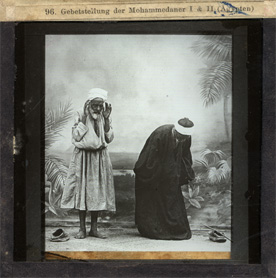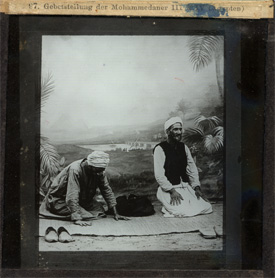Here it takes advantage of any restrictions which might have had to be observed if the women depicted were European. Photography almost
always had the possibility of contextualising itself by means of captions which maintained the necessary fictions.
 There
are indeed many parallels with photography, in the ethnological world with its project of “capturing” naked and half-naked females for science, as part
of the more general enterprise of measuring and inventing taxonomies. This is also the case in the fields of commercial
photography and popular culture such as postcard
production. Alloula analyses the production of numerous Algerian postcards in which women who would normally be veiled are photographed semi-naked.
As he points out, the “colonial photos strive for authenticity are but scenes from colonial theatre - a propaganda piece with a very long run.” Pictures
and postcards like this are almost always captioned and the captions pretend to objectivity - ethnological or socio-cultural - but the nakedness is almost
never mentioned. Linda
Steet continues this line of analysis further by looking at the National Geographic and analysing the photographs appearing there dealing
with the Arab / Orient / Orientalist world. There
are indeed many parallels with photography, in the ethnological world with its project of “capturing” naked and half-naked females for science, as part
of the more general enterprise of measuring and inventing taxonomies. This is also the case in the fields of commercial
photography and popular culture such as postcard
production. Alloula analyses the production of numerous Algerian postcards in which women who would normally be veiled are photographed semi-naked.
As he points out, the “colonial photos strive for authenticity are but scenes from colonial theatre - a propaganda piece with a very long run.” Pictures
and postcards like this are almost always captioned and the captions pretend to objectivity - ethnological or socio-cultural - but the nakedness is almost
never mentioned. Linda
Steet continues this line of analysis further by looking at the National Geographic and analysing the photographs appearing there dealing
with the Arab / Orient / Orientalist world.
|
 |
Here we are in the midst of images and imagery, which allow us to deduce something about the power structures and interests involved
generating and maintaining particular ways of seeing.
 Steet
gives the example of WJ McGee as a connection between cultural perceptions and political aims. He was involved in the Anthropology Department at the
St. Louis Exposition in 1904 (which included Ota Benga as an ‘exhibit’) and gave a lecture to, amongst others, members of the National Geographic
Society who were also the sponsors for a lecture series entitled National Growth and National Character. His work focussed on the role of Anglo-Saxons “to
subjugate lower nature, to extirpate the bad and cultivate the good among living things ... and in all ways to enslave the world for the support
of humanity and the
increase of human intelligence.” Steet
gives the example of WJ McGee as a connection between cultural perceptions and political aims. He was involved in the Anthropology Department at the
St. Louis Exposition in 1904 (which included Ota Benga as an ‘exhibit’) and gave a lecture to, amongst others, members of the National Geographic
Society who were also the sponsors for a lecture series entitled National Growth and National Character. His work focussed on the role of Anglo-Saxons “to
subjugate lower nature, to extirpate the bad and cultivate the good among living things ... and in all ways to enslave the world for the support
of humanity and the
increase of human intelligence.”
This attitude, the assumptions which drive the attitude, the blueprint for a political mission already underway, can also be linked
to the European painters. It is no coincidence that the painters were most active at the high point of British and French colonial expansion. |